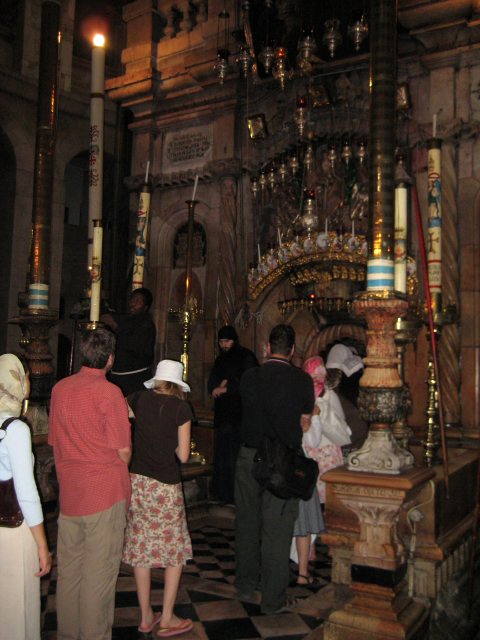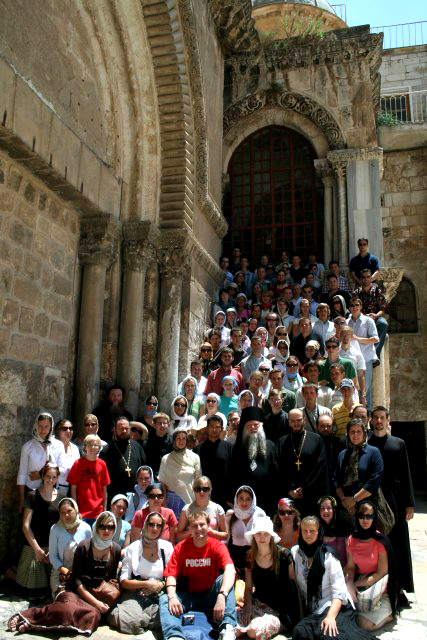
JERUSALEM: July 7, 2007
Pilgrims of the Russian Church Abroad Venerate the Life-bearing Sepulcher of the Lord and Golgotha
 On Friday, July 6, the pilgrims of the Russian Orthodox Church Outside of Russia, led by His Grace Bishop Peter of Cleveland, prayed at the Life-bearing Sepulcher of the Lord and Golgotha, and then headed for the site of the appearance of the Resurrected Christ to St Mary Magdalene, E On Friday, July 6, the pilgrims of the Russian Orthodox Church Outside of Russia, led by His Grace Bishop Peter of Cleveland, prayed at the Life-bearing Sepulcher of the Lord and Golgotha, and then headed for the site of the appearance of the Resurrected Christ to St Mary Magdalene, E qual-to-the-Apostles. The pilgrims venerated the relics and icons of the churches in the area and heard a profound sermon given by His Grace. They then went to the “Russian Excavations.” qual-to-the-Apostles. The pilgrims venerated the relics and icons of the churches in the area and heard a profound sermon given by His Grace. They then went to the “Russian Excavations.”
As we know from the Gospel, Golgotha and the nearby Sepulcher carved out of a cliff-side in the garden of Joseph of Arimathea, were “not far from the city,” meaning outside the city itself, as Apostle Paul says: “Jesus… suffered without the gate” (Hebrews 13:12).
The present wall which divides the old city from the west to the Jewish part (between the Damascus Gates and the citadel), did not exist during the earthly days of the Savior. The city wall at the time was further east, though not far from here, and had a gate which became known as the “Judgment Gate,” since there the Romans would pronounce final sentence on those who were to be executed. The wall was built in the 8 th century BC by the Judean King Ezekiel to defend Jerusalem against the Assyrians, and was rebuilt two centuries after the destruction of the city. Thus it stood in the days when the Lord Savior, making His way to Golgotha with the cross, passed through the Judgment Gates as He left the city.
The ancient wall and Gates were accidentally discovered in the 19 th century when the Russian Government purchased a piece of property near the Sepulcher of the Lord from some Abyssinians. This parcel was intended for a Russian consulate building, but when the site was cleared, the architects found the remnants of a massive wall, the stones of which were finished in a manner dating to this epoch. Construction was halted, and excavations began under the supervision of the Chief of the Russian Ecclesiastical Mission in Jerusalem, Archimandrite Antonin (Kapustin). Scholars finally ascertained that this wall was the exterior wall of the city during the Savior's time. It survived at a height of 2-2.5 meters. A worn threshold, polished from footsteps, was found between two pilasters, which had holes for gate hinges. On both sides of the threshold were uneven flagstones. Since these gates were the closest to Golgotha, there is no doubt that these are the Judgment Gates, and that the Divine Cross-bearer passed over this threshold.
Other treasures were found at the site. An archway resting upon two columns was uncovered, dating to another period. This showed that this site was part of St Constantine's Basilica, which was erected over the Lord's Sepulcher, and this archway was a part of the propylaem surrounding the grandiose church!
This discovery was acknowledged by experts throughout the world. The Russian Consulate decided to build on another site, and a church was built over this final leg of the Way of the Cross, elevated upon a wide court rising over the Gates, apparently a part of Constantine the Great's church. A stone altar table was found there, apparently part of a chapel in that church, which had once covered a whole series of holy sites. This altar table was left in place, and an altar and iconostasis were built to the east, the church then dedicated to St Alexander Nevsky. The Holy Threshold is found in this edifice, which also contained some rooms to accommodate pilgrims. The threshold is covered by a wood and glass display case. Beyond it is a large Crucifix on a shard of original stone. An ancient wall stretches out on the left, abutting a wall upon which is a large icon of the Savior carrying the Cross. These massive remains extend past the Russian parcel and continue as part of the adjacent Abyssinian monastery.
Russian clergymen from the Convent of St Mary Magdalene in Gethsemane come to this site on Great Thursday evening, after the reading of the 12 Gospels, singing and bearing candles. They are joined by the Russian residents of the Holy City, and a Passion service is conducted there on the day when the Church remembers the world-saving Passions of Her Chief, on the very site where He proceeded to Golgotha under the weight of the  Cross. The “Excavations” church is served by the clergymen of the Russian Ecclesiastical Mission (Russian Church Abroad). Cross. The “Excavations” church is served by the clergymen of the Russian Ecclesiastical Mission (Russian Church Abroad).
On the evening of July 6, the pilgrims prayed during all-night vigil on the eve of the Nativity of John the Baptist at Ascension of the Lord Convent on the Mount of Olives. The most noteworthy moment of this first day in Jerusalem was the singing by the young choir of Paschal prayers at the Sepulcher of the Lord, performed with piety, tears, and commemoration of their relatives and friends.
|